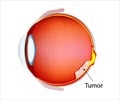Researchers at the University of Texas feel that they may have found an effective treatment for a type of non-cancerous eye tumor that threatens
Researchers at the University of Texas feel that they may have found an effective treatment for a type of non-cancerous eye tumor that threatens clear vision. Using photodynamic therapy, researchers successfully restored vision in three patients who were suffering from intraocular choroidal hemangiomas, which involved serious retinal detachments.
Intraocular choroidal hemangiomas are benign tumors, which can cause symptoms due to their location, growth, and the accumulation of fluid in the eye. Doctors generally don't treat the tumors unless the problems lead to vision loss or a detached retina.In these cases, each of the patients was suffering from a tumor in one eye, and all suffered loss of vision and a detached retina. In the first case, a 60 year old man attempted reatment after experiencing decreased visual acuity in his right eye for two weeks. In the second case, a 40 year old man came to the clinic complaining of flickering lights and decreased visual acuity in his left eye. The third subject was a 65 year old man who had been initially diagnosed in 1995 and followed for the next 5 years, during which time he began to experience significantly worsening vision and an expanding central blind spot.
Researchers used photodynamic therapy to treat the detached retinas and shrink the tumors. Photodynamic therapy includes a light-sensitive dye that produces blood clots to terminate the growth of abnormal new blood vessels. In all three cases, the therapy resolved the detached retinas and shrunk the tumors beyond measurable size. Vision improved to 20/20 for the first two patients and to 20/200 for the third patient. After 10 months to 15 months of follow-up, none of the tumors had returned. Researchers conclude photodynamic therapy appears to be effective for the treatment of choroidal hemangioma.










